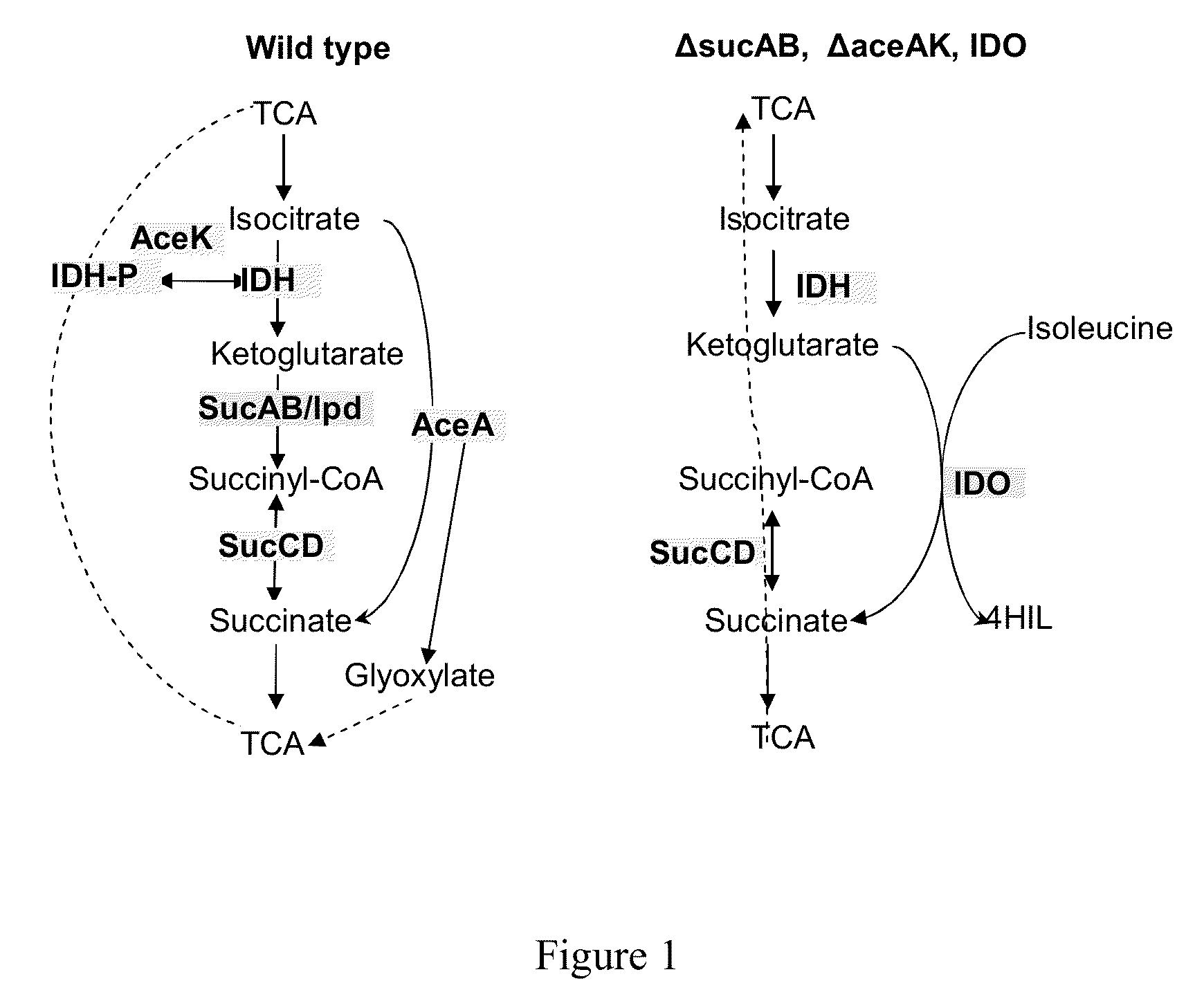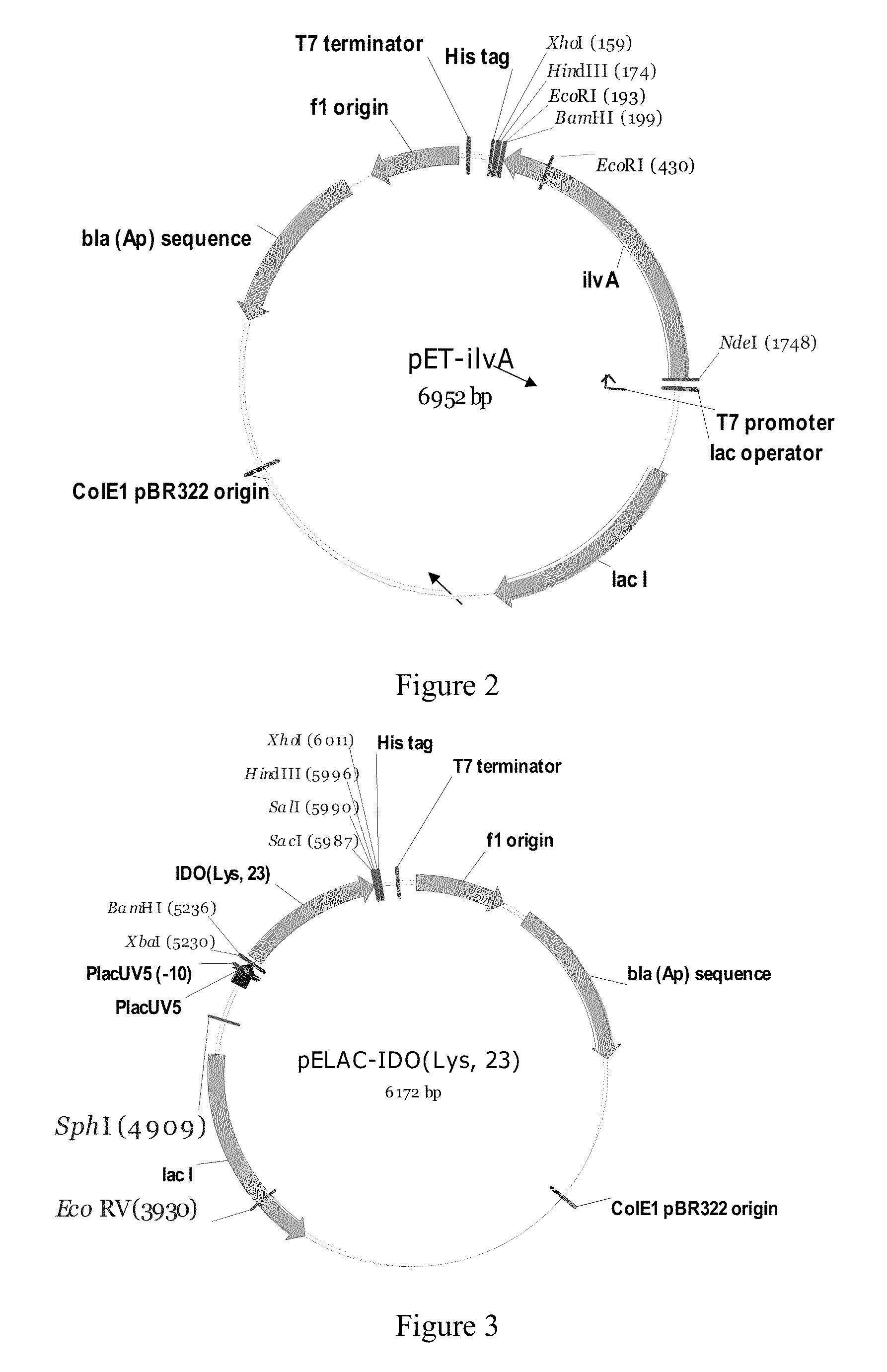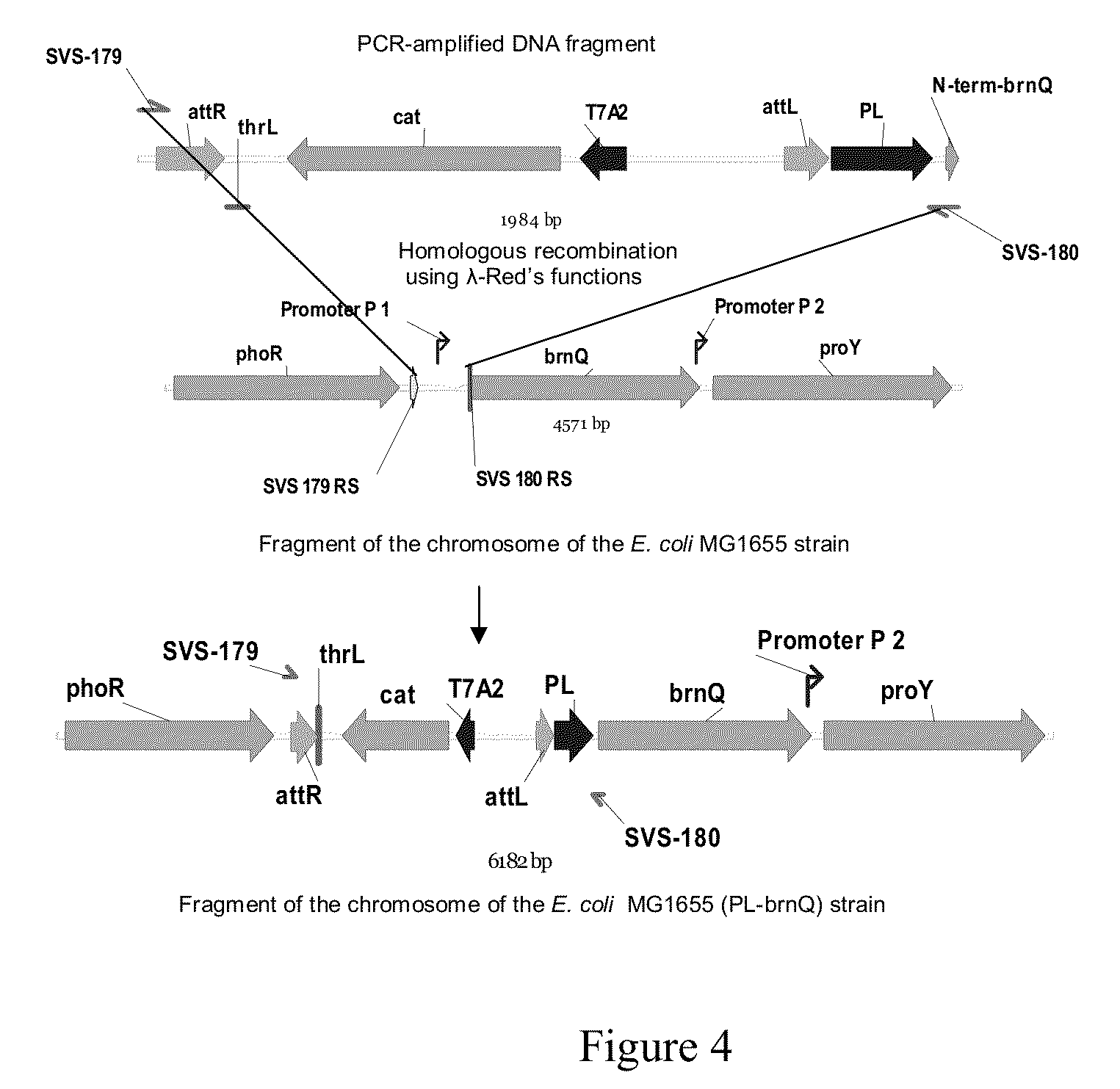Bacterium producing a product of a reaction catalyzed by a protein having 2-oxoglutarate-dependent enzyme activity and a method for manufacturing the product
a technology of enzyme activity and enzyme activity, which is applied in the field of microorganism production, can solve the problems of unsatisfactory method for manufacturing 4-hydroxy-l-isoleucine, sulfonylurea treatment, and common side effects of hypoglycemia, and achieve the effect of enhancing the production of a produ
- Summary
- Abstract
- Description
- Claims
- Application Information
AI Technical Summary
Benefits of technology
Problems solved by technology
Method used
Image
Examples
example 1
Construction of the MG1655 [pELAC-IDO(Lys, 23)] and MG1655(PL-brnQ)[pELAC-IDO(Lys, 23)] Strains
[0113]1.1. Construction of the pMW119-IDO(Lys, 23) Plasmid.
[0114]An 0.8 kb DNA fragment of the chromosome of the Bacillus thuringiensis strain 2-e-2 was amplified using oligonucleotides SVS 170 (SEQ ID No:15) and SVS 169 (SEQ ID No:16) as a primers and purified chromosomal DNA as a template. The PCR protocol was as follows: initial cycle for 30 seconds at 94° C.; 4 cycles for 40 seconds at 94° C.; 30 seconds at 49° C.; 40 seconds at 72° C.; 35 cycles for 30 seconds at 94° C.; 30 seconds at 54° C.; 30 seconds at 72° C. The PCR fragment was digested with BamHI and SacI endonucleases and then ligated into the pMW119 vector which had been previously treated with the same restrictases.
[0115]1.2. Construction of the pELAC-IDO (Lys, 23) Plasmid.
[0116]A 0.76 kb DNA fragment was excised from the pMW119-IDO(Lys, 23) plasmid with the XbaI, SacI endonucleases, and then cloned into the pELAC-ilvA / XbaI-...
example 2
Production of 4HIL by E. coli Strain MG1655(PL-brnQ)[pELAC-IDO(Lys, 23)]
[0124]To test the effect of enhanced expression of a gene coding for L-isoleucine transporter on 4HIL production, cells of the MG1655 [pELAC-IDO(Lys, 23)] and MG1655(PL-brnQ)[pELAC-IDO(Lys, 23)] strains were grown in LB medium supplemented with ampicillin (200 μg / ml) and IPTG (1 mM) at 37° C. for about 4-5 hours. Specific IDO activity was measured in crude protein extracts for each grown recombinant E. coli strain as follows. Cells from 5 ml of culture were harvested by centrifugation at 4° C., re-suspended in 0.5 ml of buffer A*(50 mM TRIZMA, 5% glycerol, 1 mM EDTA, 1 mM DTT, pH 7 adjusted by HCl) and disrupted by sonication at 4° C. The reaction mixture (50 μl) contained 50 mM HEPES pH 7.0; 5 mM Ile; 0.5 mM α-ketoglutarate; 5 mM ascorbate; 5 mM FeSO4 and an aliquot of the protein preparation. The reaction was incubated at 34° C. for 1 hour with shaking. 4HIL was detected using TLC or HPLC analysis as follows. ...
example 3
Construction of the MG1655 (ΔsucAB, ΔaceAK, PL-brnQ) [pELAC-IDO(Lys, 23)] Strain
[0129]3.1. Construction of the MG1655 (ΔsucAB) Strain.
[0130]To delete the sucAB genes, the following manipulations were carried out. A 1.8 kb DNA fragment containing a CmR-marker and the Ptac promoter was amplified by PCR with oligonucleotides SVS-192 (SEQ ID No:19) and SVS-193 (SEQ ID No:20) as primers and chromosomal DNA of the MG1655(attR-Cm-attL-Ptac) strain (Katashkina J. I. et al., Molekularnaya biologiya(RU), v. 39, No. 5, 1-10 (2005)) as the template. Conditions for PCR were as follows: denaturation step for 3 min at 95° C.; profile for two first cycles: 1 min at 95° C., 30 sec at 50° C., 40 sec at 72° C.; profile for the last 25 cycles: 30 sec at 95° C., 30 sec at 54° C., 40 sec at 72° C.; final step: 5 min at 72° C.
[0131]A 1.8 kbp PCR product was obtained and purified in agarose gel and was used for electroporation of the E. coli strain MG1655, which contains the plasmid pKD46 having a temperat...
PUM
| Property | Measurement | Unit |
|---|---|---|
| pH | aaaaa | aaaaa |
| temperature | aaaaa | aaaaa |
| pH | aaaaa | aaaaa |
Abstract
Description
Claims
Application Information
 Login to View More
Login to View More - R&D
- Intellectual Property
- Life Sciences
- Materials
- Tech Scout
- Unparalleled Data Quality
- Higher Quality Content
- 60% Fewer Hallucinations
Browse by: Latest US Patents, China's latest patents, Technical Efficacy Thesaurus, Application Domain, Technology Topic, Popular Technical Reports.
© 2025 PatSnap. All rights reserved.Legal|Privacy policy|Modern Slavery Act Transparency Statement|Sitemap|About US| Contact US: help@patsnap.com



